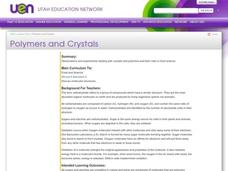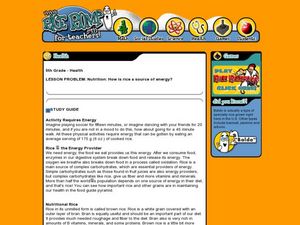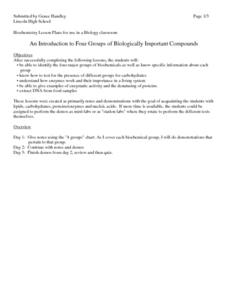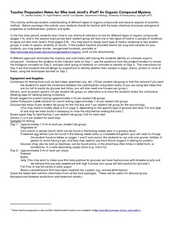Nemours KidsHealth
Healthy Snacking: Quiz (Grades 9-12)
Test your learners' healthy snacking know-how with this quiz. This quiz is made up of 10 questions about how to choose a healthy snack. Topics include food labels, carbohydrates, healthy snack choices, and high-fat foods. Use this quiz...
Nemours KidsHealth
Healthy Snacking: Snack Report Card
In this healthy snacking worksheet, high schoolers complete a "report card" for snacks found at their school. They include the type of snack, the grams of carbohydrates, sugar, protein, and fat, the calories, the vitamins, and the grade...
Curated OER
The Chemical Building Blocks of Life
Amateur biologists examine the macromolecules that are foundational to life: proteins, lipids, and carbohydrates. This worksheet is composed of five pages of questions and plenty of space to write answers. Learners will explore...
Curated OER
Polymers and Crystals: Their Role in Food Science
Blend chemistry with cooking in this exploration of polymers, carbohydrates, and food science. Experimenting with gelatin produces concrete examples of the bonding and ploymerization discussed in the lesson. Copious, comprehensive...
Curated OER
Biological Molecules
Ninth graders examine the structure and function of biomolecules. In this food molecule lesson, 9th graders will examine various types of biomolecules such as carbohydrates, lipids, proteins, and nucleic acids. They will...
Curated OER
Organic Compounds
Your young biologists will find these slides very useful to help differentiate between the different nutritional components. The slides contain step by step details of the different levels of structure and function. These would be...
Curated OER
Menu for an Athlete
Football, basketball, softball. What do these sports have in common? Athletes. Young scholars learn about and discuss the food pyramind, especially grains, with the thought that they will be planning a pre-competition meal and snack for...
Curated OER
Catering Middle-School Science: Monomers, Polymers, and Macromolecules
Students investigate foods. In this biology lesson plan, students will conduct testing on different types of foods as they learn about different molecules that make them up. Students will also learn about the shapes of the molecules.
Curated OER
Testing for Life
Students test for organic molecules to determine if a solution contains once living molecules. In this characteristics of life lesson plan, students test common liquids for the presence of organic molecules, including starch, protein,...
Curated OER
Rice as a Source of Energy
Fifth graders investigate the nutrition in rice. In this rice lesson, 5th graders discover that rice is a great source of energy. Students compare foods to rice to see the differences in the nutritional value. Students classify foods in...
Curated OER
Lesson 1: Fast Food Nutrients
Students compute the nutrient values of fast foods. For this fast food nutrient, students observe a PowerPoint about nutrition. They research nutritional topics, answer questions about nutrition, and determine the nutrient values of...
Curated OER
An Introduction to Four Groups of Biologically Important Compounds
High schoolers learn about the four biochemicals that are important biologically. In this biochemicals lesson plan, students identify the four major groups of biochemicals including carbohydrates, proteins, lipids and nucleic acids. They...
Curated OER
Carbohydrates Worksheet
In this carbohydrates worksheet, students answer 8 questions about the structure of carbohydrates, the reactions involved with them and the chemical structure of them.
Curated OER
Vitamin C and Protein Analysis
Students analyze various beverages to determine vitamin C content. Students research diseases resulting from vitamin C deficiencies and identify countries most affected.
Curated OER
Energy Balance: The Ins and Outs
Students review data from a 24-hour dietary recall to gain a practical understanding of information regarding energy intake and macronutrients.
Curated OER
Biomolecules
Students perform an experiment in which they test foods for the presence of proteins, carbohydrates, and lipids. They identify the molecular structure of each type of biomolecule and then discuss how biomolecules relate to nutrition and...
Curated OER
Who Took Jerell's iPod?
Students investigate various substances to determine the perpetrator of a crime. In this biology lesson plan, students test for the presence of organic compounds in various samples. They identify an unknown substance based on its...
Curated OER
Healthy Eating Habits
This Healthy Eating PowerPoint summarizes what the different parts of food are and some important examples and facts about each.
Curated OER
How to Cook Rice
Fourth graders discover how to cook rice. In this cooking lesson, 4th graders discover how to cook rice correctly. Students read and follow cooking directions and discuss how their rice turned out.
Curated OER
Cholesterol and Carbohydrates
In this cholesterol and carbohydrates worksheet, students answer multiple choice questions on cholesterol and carbohydrates. Students complete 4 questions.
Curated OER
Murder and a Meal
In this murder and a meal worksheet, students read the given scenario and determine a procedure to test each organic macromolecule stated in the reading. Students write out the procedure for testing. Students complete a chart that...
Curated OER
Fats
In this fats worksheet, students review what fats are made up of, where fats come from, and how our body uses fats. Then students access a website to compare good fats and bad fats. This worksheet has 1 graphic organizer, 13 short answer...
Curated OER
Biochemistry Quiz
In this biochemistry learning exercise, students review amino acids, proteins, lipids, and carbohydrates. This learning exercise has 29 multiple choice, 8 fill in the blank, and 3 short answer questions.
Curated OER
Biologically Important Molecules
In this biologically important molecules worksheet, students fill in the blank with information about carbohydrates, lipids, and proteins. Students also make notes about nucleic acids.

























